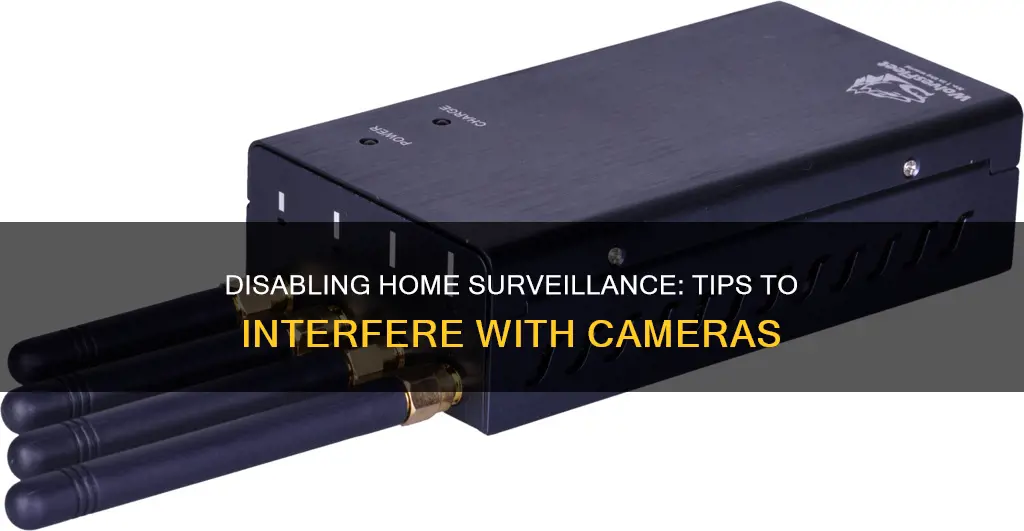
Home surveillance cameras are becoming increasingly popular, providing an easy and cost-effective way to monitor your property. However, these devices can be vulnerable to interference from outside sources, which can have serious legal and safety implications. Interfering with wireless cameras can be tricky, and it is important to understand the different types of cameras, the sources of interference, and the legal consequences of your actions. In this article, we will discuss the steps you can take to interfere with home surveillance cameras, the potential risks involved, and how to protect your own cameras from interference.
| Characteristics | Values |
|---|---|
| Camera type | Analog or digital |
| Source of interference | Physical obstructions, other wireless devices, or electronics |
| Solutions | Adjust camera settings, upgrade camera system, use a jammer device, install shielding materials, move router, use a WiFi range extender |
| Blocking methods | Tall trees, fences, curtains, cheap posts with cloth flags, moving objects, IR lights, LEDs, laser pointers, camera jammers, hacking, spray paint |
What You'll Learn

Use a jammer device to interfere with the camera's signal
Using a jammer device to interfere with a camera's signal is one way to disrupt a home surveillance system. A wireless signal jammer emits a powerful signal in the same frequency range as the camera, blocking its signal and rendering it unable to transmit video footage. These jammers can be effective against wireless cameras that rely on Wi-Fi or Bluetooth connections. However, it is important to note that the use of wireless signal jammers is illegal in many places, as they can interfere with essential communication systems and emergency services.
When choosing a wireless signal jammer, it is important to select one that emits radio frequencies that match the camera's wireless communication frequency. This ensures that the jammer's signal will effectively block or distort the camera's signal. Additionally, some jammers may have adjustable settings that allow you to target specific frequencies or types of cameras.
To use a wireless signal jammer effectively, you need to position it within a certain range of the camera. The jammer's signal strength and the distance it can cover will vary depending on the model and design. It is recommended to place the jammer as close to the camera as possible to ensure maximum signal disruption.
While wireless signal jammers can be effective at interfering with camera signals, they may not work on all types of cameras. Some modern cameras have anti-jamming technology or advanced algorithms that can maintain their connection even in the presence of interference. Additionally, wired cameras that use a physical connection, such as coaxial or Ethernet cables, may not be affected by wireless jammers.
It is crucial to use wireless signal jammers responsibly and within legal boundaries. Interfering with security cameras without proper authorization is illegal and unethical. Before considering the use of a jammer, individuals should explore legal and ethical alternatives, such as consulting local authorities or seeking professional advice on addressing security concerns.
The Keystone K7 Camera: A Rare Vintage Find
You may want to see also

Install shielding materials around the camera
To interfere with a home surveillance camera, you can install shielding materials around the camera to reduce external interference. This method is more effective and legal compared to other methods such as using laser pointers or spray paint, which can be considered vandalism or destruction of property.
- Identify the type of camera: It is important to understand whether the camera is analog or digital. Analog cameras transmit footage via a continuous signal, while digital cameras compress information into smaller data packets transmitted over longer distances. This distinction will help you choose the appropriate shielding materials.
- Assess the camera's surroundings: Take note of any physical obstructions or potential sources of interference, such as walls, metal surfaces, trees, or other wireless devices operating in the same frequency range. This will help you determine the extent and type of shielding required.
- Choose suitable shielding materials: Install shielding materials like Faraday cages or copper meshes, which are specifically designed to block or absorb unwanted signals. These materials will prevent external signals from reaching the camera's receiver and minimise interference from other wireless devices. Ensure that the shielding materials are large enough to cover all possible entry points for signals.
- Install the shielding materials: Carefully position and secure the chosen shielding materials around the camera, ensuring that all sides are covered. Make sure that the shielding does not obstruct the camera's field of view or its essential functions. This installation should be done with precision to ensure maximum effectiveness.
- Test and adjust: Once the shielding materials are in place, test the camera to ensure that the interference has been reduced. If necessary, make adjustments to the positioning or coverage of the shielding materials. You may need to experiment with different configurations to achieve optimal results.
By following these steps, you can effectively interfere with a home surveillance camera by installing shielding materials. Remember to be cautious and informed about the legal implications of interfering with surveillance equipment, as mentioned earlier.
Browning Trail Cameras: Maximizing Battery Life
You may want to see also

Identify potential sources of interference
To interfere with a home surveillance camera, it is important to first identify potential sources of interference. This can include various physical and wireless sources.
Physical obstructions such as walls, trees, fences, curtains, and other solid objects can block the camera's line of sight, creating blind spots. Additionally, tall shrubs or trees planted near the camera can obstruct its view, providing a natural barrier.
Wireless interferences are also common. Other wireless devices operating in the same frequency range, such as routers, mobile phones, microwaves, cordless phones, and Bluetooth devices, can interfere with the camera's signal. These devices may emit signals that overlap with the camera's frequency, causing disruption.
Furthermore, certain electronic equipment, such as those emitting strong infrared radiation or laser pointers, can also interfere with the camera's functionality. However, it is important to note that using such equipment to intentionally block or damage a camera may be illegal and considered vandalism or destruction of property.
It is also worth mentioning that some cameras may be more susceptible to interference than others. For instance, analog cameras transmit footage via a continuous signal, which can be more easily disrupted compared to digital cameras that use data packets.
By understanding these potential sources of interference, one can devise strategies to effectively interfere with home surveillance cameras while also being mindful of any legal implications.
UK's Surveillance Camera Network: How Extensive Is It?
You may want to see also

Adjust camera settings to minimise interference
Adjusting camera settings can be an effective way to minimise interference with home surveillance cameras. Here are some detailed instructions to help you achieve optimal performance and reduce interference:
Camera Settings for Optimal Performance
- Pixels and Image Qualitypixels for identification. The number of pixels directly impacts the level of detail in the image.
- Shutter Speed: Adjust the shutter speed to minimise motion blur, especially if the camera is set to factory default settings. A faster shutter speed will freeze motion and improve identification, but it will also reduce night-time sensitivity, so ensure there is adequate lighting.
- Gain Control: Limit the automatic gain control (AGC) to a specific level, such as 24dB, and compensate for the reduced boost with better lighting. Excessive gain can amplify noise and degrade image quality.
- Lighting: Provide adequate lighting to improve image clarity and reduce noise. Avoid backlighting and consider adding frontal lighting from the camera's perspective to enhance facial details.
- Lens Quality: Invest in good-quality lenses to improve image sharpness. Ensure proper focus, especially at night, as incompetent installation or maintenance can result in blurry images.
- Focus and Hyperfocal Distance: To maximise the number of objects in focus, calculate the hyperfocal distance and focus the lens accordingly. For example, if your camera is set up to monitor a 50-metre corridor with a 9mm lens and an F1.6 aperture, the hyperfocal distance should be 4.65 metres, not 50 metres.
- White Balance: If your camera has issues with colour accuracy, check its settings to ensure it is configured for outdoor use. If it has automatic white balance (ATW or AWB), angle the camera away from the sky and direct light sources. If issues persist, disable automatic white balance and adjust it manually.
- Video Quality and Resolution: Reduce the video quality or resolution to minimise bandwidth consumption and interference from other devices or networks.
- Frame Rate: Lower the frame rate or refresh rate to reduce motion blur and network traffic.
- Noise Reduction and Anti-Flicker: Enable these features to minimise noise and flicker caused by power supply or lighting issues.
- Night Vision or Infrared: Enable this feature to improve visibility and clarity in low-light conditions.
- Firmware and Software Updates: Keep your camera's firmware and software up to date to fix bugs, add features, and improve compatibility and performance.
Additional Tips to Minimise Interference
- Signal Strength: Improve the signal strength between your camera and router by reducing the distance and obstacles between them.
- Frequency and Channel: Change the WiFi channel or frequency used by your camera and router to find a less congested option. Consider using the 5 GHz band for higher speed and reduced interference, although it offers a shorter range.
- Conflicting Devices: Minimise or eliminate conflicting devices that operate on the same frequency or band as your camera. Move or turn off unnecessary wireless devices, such as smartphones, tablets, and game consoles.
- Wired Connections: Opt for wired connections instead of wireless ones for devices that consume a lot of bandwidth, such as smart TVs or gaming consoles. This will reduce congestion and interference on the WiFi network.
- Shielding: Use shielding materials, such as Faraday cages or copper meshes, to block or absorb unwanted signals and minimise interference from other wireless devices.
Transform Old Cellphones into Surveillance Cameras with Wi-Fi
You may want to see also

Upgrade to a newer, more powerful camera
Upgrading to a newer, more powerful camera can be a great way to improve your home surveillance system. Here are some tips to help you with the process:
Firstly, it's important to assess the health of your current security camera system. Check for any pre-existing issues by examining the monitor or TV attached to the recorder. Common problems include strobing or rolling lines, rainbow lines, glitchy videos, off-colour videos, and duplicated camera feeds. These issues are often due to worn-out or damaged cables, which can affect both your old and new DVR (Digital Video Recorder).
The next step is to identify the type of cable you have installed. There are several types of security camera cables, including thin premade cables, RG59 coax cables, and Ethernet cables with baluns for coax cameras. The type of cable you have will determine the cameras it can support. For example, thin premade cables are typically used in low-cost security systems and can only support low-resolution analog cameras. On the other hand, RG59 coax cables are the gold standard for analog security systems and can support 4K video up to 600 feet.
When choosing a new camera, consider the resolution, angle of view, night vision capabilities, and smart motion detection features. Resolution is crucial for clear video footage. You can mix and match resolutions based on your needs. For instance, a 1080p camera may be sufficient for seeing a face 20 feet away, but you might need a 4K camera to see a face 50-70 feet away. The angle of view determines how wide of an area the camera can capture. For instance, a 90-degree angle of view in the corner of a room would allow you to see both sides of the room. Night vision will provide visibility in low-light conditions, and smart motion detection can help improve the accuracy of alerts by differentiating between people, vehicles, and pets.
If you want to upgrade to 4K cameras for your entire surveillance system, it is recommended to replace any existing coax cable with new Ethernet cable runs. Most Power over Ethernet (PoE) cameras are not too particular about cable quality, but you are limited to a maximum cable length of 328 feet before needing extenders.
Finally, consider upgrading your recorder to a newer model. This will allow you to take advantage of newer, more powerful security cameras and their advanced features. Pay attention to the supported resolutions and compatibility concerns when choosing a new DVR or NVR (Network Video Recorder). Make sure the recorder can handle the resolution of your new cameras, and check for signal compatibility with coax cameras and software compatibility with IP cameras.
Mastering the Samsung S20 Camera Focus: Tips and Tricks
You may want to see also
Frequently asked questions
Using a jammer device that operates on the same frequency as the camera's receiver is the most effective method. This will create noise on the line and render the camera inoperable.
Yes, interfering with wireless camera broadcasts can be considered an intentional disruption of the airwaves and may result in misdemeanor or felony charges, depending on the jurisdiction. It is important to consult local laws before attempting any interference.
Cell-jamming is the use of a device to intentionally block or interfere with radio or wireless signals. This can be done with a device placed roughly 30 feet from the target camera, rendering it inoperable. However, it is important to note that cell-jamming is illegal in many places, including the US.
Aside from signal jamming, you can improve the security of your home surveillance system by using up-to-date technology with encryption and opting for wired connections instead of Wi-Fi. Additionally, physical security measures such as good lighting, alarm systems, and trimming bushes can also deter intruders.







